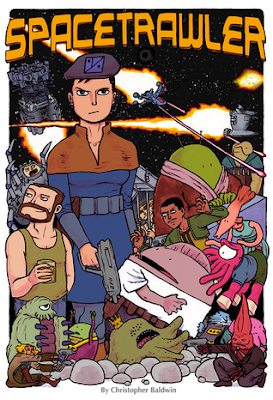“A system that operates by constructing and executing plans lives, to speak metaphorically, in a sort of fantasy world..." -Agre and Chapman 1990
Saturday, December 24, 2022
State of the Blog Year 4
Sunday, October 9, 2022
Emerald Empire Sessions 2 and 3: A Writ of Justice
Saturday, October 1, 2022
Legend of the 5 Rings Megapost
Emerald Empire Session 1: Sunrise Over The Empire
L5R 4e Primer
Wednesday, June 29, 2022
An Alternative Humanity in Vampire: the Masquerade
Thursday, May 5, 2022
Read This: Spacetrawler the Webcomic
Saturday, April 16, 2022
Julius Wavestone Keeps Killing!
Thursday, April 7, 2022
Secret Jackalope: Rare Bugs and Spiders and their Uses
 |
| HAIL THE JACKALOPE! IA! IA! |
Monday, March 28, 2022
Books for Dungeon Masters: The Peregrine, by J.A. Baker
"There is always a sense of loss, a feeling of being forgotten. There is nothing else here; no castles, no ancient monuments, no hills like green clouds. It is just a curve of the earth, a rawness of winter fields. Dim, flat, desolate lands that cauterise all sorrow. I have always longed to be a part of the outward life, to be out there at the edge of things, to let the human taint wash away in emptiness and silence, as the fox sloughs his smell into the cold unworldliness of water; to return to the town as a stranger. Wandering flushes a glory that fades with arrival.
I came late to the love of birds. For years I saw them only as a tremor at the edge of vision. They know suffering and joy in simple states not possible for us. Their lives quicken and warm to a pulse our hearts can never reach. They race to oblivion. They're old before we have finished growing.
The first bird I searched for was the nightjar, which used to nest in the valley. Its song is like the sound of a stream of wine spilling from a height into a deep and booming cask. It's an odorous sound, with a bouquet that rises to the quiet sky. In the glare of day it would seem thinner and drier, but dusk mellows it and gives it vintage. If a song could smell, this song would smell of crushed grapes and almonds and dark wood. The sound spills out and none of it is lost, the whole wood brims with it. Then it stops, suddenly, unexpectedly, but the ear hears it still, a prolonged and fading echo draining and winding out of the surrounding trees. Into the deep stillness between the early stars and the long afterglow, the nightjar leaps up joyfully, it glides and flutters, dances and bounces, lightly, silently, away."
Of sparrow hawks:
"Sparrow hawks were always near me in the dusk, like something that I meant to say, but could never quite remember ... They lived a fugitive, guerrilla life. In all the overgrown, neglected places the frail bones of generations of sparrow hawks are sifting down now into the deep humus of the woods. They were a banished race of beautiful barbarians, and when they died they could not be replaced."
"He re-enacts the whole process of learning to kill that he went through when he first left the eyrie. The first short, tentative flights, the longer, more confident ones, the playful mock attacks at inanimate objects such as falling leaves or drifting feathers, the games with other birds changing to a pretense or attack, and then to the first serious attempt to kill. True hunting may be a comparatively brief process at the end of this long re-enactment of the hawk's adolescence.
Hunting is always preceded by some form of play. The hawk may feint at partridges, harass jackdaws or lapwings, skirmish with crows. Sometimes, without warning, he will suddenly kill. Afterwards, he seems baffled by what he's done, and he may leave the kill where it fell and return to it later when he is genuinely hunting. Even when he is hungry, and has killed in anger, he may sit beside his prey for ten to fifteen minutes before starting to feed. In these cases the dead bird is usually unmarked, and the hawk seems to be puzzled by it. He nudges it idly with his bill. When blood flows, he feeds at once."
"He hovered, and stayed still, striding on the crumbling columns of air, curved wings jerking and flexing. Five minutes he stayed there, fixed like a barb in the blue flesh of the sky. His body was still and rigid, his head turned from side to side, his tail fanned open and shut, his wings whipped and shuddered like canvas in the lash of the wind. He side-slipped to his left, paused, then glided round and down into what could only be the beginning of a tremendous stoop. There is no mistaking the menace of that first easy drifting fall. Smoothly, at an angle of fifty degrees, he descended; not slowly, but controlling his speed; gracefully, beautifully balanced. There was no abrupt change. The angle of his fall became gradually steeper till there was no angle left, but only a perfect arc. He curved over and slowly revolved, as though for delight, glorying in anticipation of the dive to come. His feet opened and gleamed golden, clutching up towards the sun. He rolled over, and they dulled, and turned towards the ground beneath, and closed again. For a thousand feet he fell, and curved, and slowly turned, and tilted upright. Then his speed increased, and he dropped vertically down. He had another thousand feet to fall, but now he fell sheer, shimmering down through dazzling sunlight, heart-shaped, like a heart in flames. He became smaller and darker, diving down from the sun. The partridge in the snow beneath looked up at the black heart dilating down upon him, and heard a hiss of wings rising to a roar. In ten seconds the hawk was down, and the whole splendid fabric, the arched reredos and immense fan-vaulting of his flight, was consumed and lost in the fiery maelstrom of the sky.And for the partridge there was the sun suddenly shut out, the foul flailing blackness spreading wings above, the roar ceasing, the blazing knives driving in, the terrible white face descending, hooked and masked and horned and staring-eyed. And then the back-breaking agony beginning, and snow scattering from scuffling feet, and show filling the bill’s wide silent scream, till the merciful needle of the hawk’s beak notched in the straining neck and jerked the shuddering life away.And for the hawk, resting now on the soft flaccid bulk of his prey, there was the rip and tear of choking feathers, and hot blood dripping from the hook of his beak, and rage dying slowly to a small hard core within.And for the watcher, sheltered for centuries from such hunger and such rage, such agony and such fear, there is the memory of that sabring fall from the sky, and the vicarious joy of the guiltless hunter who kills only through his familiar, and wills him to be fed."
Saturday, March 5, 2022
Sticky Alignments
Friday, March 4, 2022
Running the Campaign: The Stinger
A woman sits on a majestic throne before a roaring fire, in a secret keep deep below the city of Ptolus. A portly dwarf, Dollin Ebonhome, the head of the Killraven operation in North Market, kneels at her side, bloody and beaten."It was all Durant's idea! Please!"The woman contemplates the fire, and sips mead from a goblet. "North Market was your turf, Dollin. Why was Durant acting as he pleased there, without you doing anything?" The goblet is made from a dwarven skull."I just needed help making collections, he- he just got out of contro-" The snout of a gold-plated dragon pistol presses to his forehead."Tell me again how things got out of your control.""MISTRESS KILLRAVEN!"A bang fills the chamber. The dwarf's brains coat the rug.Behind the throne, something, something tall, with the long arms of an ape and the eyes of a goat and the teeth of a wood chipper leans down and slurps out the remains."Get this to Korben in South Market. I'm sure he could use the ... motivation. Then convene the Pactlords for tomorrow night, and make an example of Durant's worms. We make our move on Godsday. And see to it that these mice don't make any more trouble."The thing's shape melts and reforms like water, into a young woman with red hair and an impish smile—Tellith Herdsman. Then into a diminutive, wiry gnome—Anageo Quigg—and again into an elderly woman, the Administration building requisitions officer. On the table before them are four dossiers.Jaiden Cunningham: ELIMINATIONMiranir: ELIMINATIONDmitree: ELIMINATIONLucien Chenier: ELIMINATION
Saturday, February 12, 2022
Adventures in Rekeying
5. ICE CAVERN: The giants have frozen 8 corpses of mutilated victims. standing them upright in blocks of transparent ice. Evidently these are meant to "frighten off" any trespassers. The bodies are obviously hacked and very dead, not merely frozen whole. Each of these corpses has some valuable item with it in the ice: 1) is dwarven with a battle axe +1, 2) is elven with a long case at its feet (cold wand with 16 charges), 3) is human and wears a jeweled belt (worth 7,000 g.p.), 4) Is human and has a tube In its hand (a scroll of protection from elementals), 5) is dwarven and has a spilled pouch of (3710 g.p. base value) gems at its feet, 6) is human and wears a fire resistance ring, 7) is half-elven and grasps a sack with a burst seam showing silvery coins (471 s.p.). and 8) is a human In gleaming armor (magic armor of vulnerability,-2 but appears as +2 until actually struck in combat). If a fireball is used to melt the ice blocks, all magic and jewelry will be destroyed. Lesser fires or chipping will cause melting or vibrations which have a 10% per block cumulative chance of causing the ceiling of ice and Icicles to collapse and inflict 6-60 hit points of damage on each creature beneath.
5. Ice Cavern. (4’’x3’’) 8 standing blocks of ice contain mutilated corpses, each with a valuable item within.
If a fireball is used to melt the ice, all magic and jewelry is destroyed. Lesser fires or chipping has a 10% per block cumulative chance of causing the ceiling to collapse for 6d10 damage on each creature beneath.
Dwarf with a battleaxe+2.
Elf with a cold wand (16 charges) in a long case.
Human wears a jeweled belt (7,000 g.p.).
Human holds a scroll of protection from elementals in a tube.
Dwarf with a spilled pouch of gems (3710 g.p. Base value).
Human wears a fire resistance ring.
Half-elf grasps a burst sack of silver (471 s.p.).
Human in gleaming armor (armor of vulnerability -2, appears as +2 until first struck).









